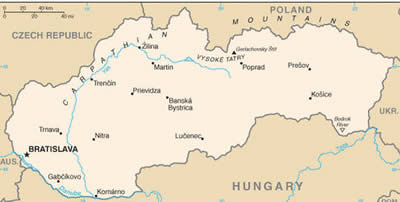
Slovak
Slovak (Slovenský jazyk), also called Slovakian, belongs to the West Slavic group of the Slavic branch of the Indo-European language family. It is spoken by 4.75 million people in Slovakia. There are also expatriate Slovak communities in Canada, Hungary, Poland, Romania, Serbia and Montenegro, Ukraine, and USA.
Status
Slovak is the official language of the Slovak Republic. Standard Slovak is used in government administration, all levels of education, and in all media.
Dialects
Slovak dialects are fragmented by the country’s mountainous terrain, however, they are mutually intelligible. Slovak is usually divided into three major dialect areas:
- Central Slovak on which Standard Slovak is primarily based;
- Western Slovak which merges with the Moravian dialect of Czech;
- Eastern Slovak which merges with Polish dialects along the border with Poland.
Structure
Sound system
Vowels
Slovak has five vowel phonemes, i.e., sounds that differentiate word meaning. All vowels can be long or short. Vowel length makes a difference in the meaning of words.In the table below, vowel length is indicated by a colon.
| Close |
i, i:
|
u, u:
|
|
| Mid |
e, e:
|
o, o:
|
|
| Open |
a, a:
|
Consonants
The consonant system of Slovak has the following general features:
- There is a large variety of consonant clusters.
- Four consonants can be plain or palatalized.
- There is voice assimilation, e.g., bt is pronounced as [pt], and tb is pronounced as [db] with the last consonant in the cluster determining if the whole cluster is voiceless or voiced, e.g., bt is pronounced as [pt], and tb is pronounced as [db].
- Voiced stops are devoiced in final position, e.g., dub ‘oak’ is pronounced as [dup]. The consonant [l] and [r] are syllable-forming, e.g., plny ‘full’ or prst ‘finger.’
|
Glottal
|
||||||||
|---|---|---|---|---|---|---|---|---|
|
voiceless
|
p
|
t
|
c
|
k
|
||||
|
voiced
|
b
|
d
|
ɟ
|
g*
|
||||
|
voiceless
|
f*
|
s
|
ʃ
|
x
|
||||
|
voiced
|
v
|
z
|
ʒ
|
ɦ
|
||||
|
voiceless
|
ts
|
tʃ
|
||||||
|
voiced
|
dz
|
dʒ
|
||||||
|
m
|
n
|
ɲ
|
||||||
|
l
|
||||||||
|
r
|
||||||||
|
j
|
- * /f/ and /g/ are found mostly in loanwords
- /x/ = ch in Loch
- /ʃ/ =sh in shape
- /ʒ/ = s in measure
- /ɦ/ has no equivalent in English
- /tʃ/ = ch in chat
- /dʒ/ = j in jet
- /c/ = ts in Betsy
- /ɟ/ = j in juice
- /ɲ/ = first n in canyon
Stress
Stress always falls on the first syllable of a word.
Grammar
Slovak is a highly inflected synthetic language with a grammar that is very similar to that of other Slavic languages. Grammatical categories are expressed by adding synthetic inflections to the stems of nouns, adjectives, verbs, and most pronouns. All native Slovak stems, as well as most borrowings from other languages, are inflected.
Nouns, adjectives, pronouns, and numerals
Slovak nouns are marked for gender, number, and case. The three categories are fused into one ending, as is the case in all Slavic languages.
- There are three genders: masculine, feminine, and neuter. Each gender has its own declensional paradigm: hard (unpalatalized) stems, soft (palatalized) stems, and special types of stems.
- There are two numbers: singular, and plural, with some vestiges of the dual number.
- There are seven cases: Nominative, Genitive, Dative, Accusative, Instrumental, Locative, Vocative. However, only a few nouns have retained the vocative forms.
- Masculine nouns have animate endings in the Dative, Accusative, and Locative singular, and Nominative plural and Accusative plural.
- Adjectives agree with the nouns they modify in gender, number, and case. Like nouns, they have both hard- and soft-stem declensions.
- Pronouns use endings from noun and adjective declensions. Personal pronouns have full and short forms. Slovak distinguishes between the 2nd person singular informal ty and formal vy.
- Cardinal numerals are inflected for case. The numerals jeden ‘one’ and dva ‘two’ are also marked for gender. Ordinal numerals are declined like adjectives.
Verbs
Slovak verbs have conflated endings that express person and number for non-past conjugations; and gender, number, and person for past conjugations. They agree with their subjects in person and number.
- Slovak verbs have three persons: first, second, third. Like all Slavic languages, Slovak is a pro-drop language, i.e., personal pronouns are normally dropped because the verb ending makes the person clear. Pronouns are used only for emphatic purposes.
- There are two tenses: past, non-past. Present and future tenses have the same endings.
- There are two aspects: imperfective and perfective. Perfective and imperfective verbs are formed from basic verb roots by adding prefixes and suffixes. Non-past conjugation of perfective verbs indicates future tense, non-past conjugation of imperfective verbs indicates present tense. Imperfective verbs form future tense with the auxiliary verb byt ‘be.’
- Slovak has three moods: indicative, imperative, conditional.
- There are two voices: active and passive.
- Verbs of motion constitute a special subcategory of verbs. They are characterized by a complex system of directional and aspectual prefixes and suffixes.
Word order
The neutral word order in Slovak is Subject-Verb-Object. However, other orders are also possible since inflectional endings take care of clearly marking grammatical relations and roles in the sentence. Word order is principally determined by topic (what the sentence is about, or old information) and focus (new information). Constituents with old information precede constituents with new information, or those that carry the most emphasis.
Vocabulary
Most Slovak vocabulary is derived from Proto-Slavic roots, shared by all Slavic languages. In addition, Slovak has been influenced by a number of languages, especially Old Church Slavonic, introduced into the area by St. Cyril and St. Methodius in the 9th century, as well as by Latin, neighboring Hungarian, and most recently by English.
Here are a few common phrases in Slovak.
| Hello, good day. | Dobrý deň, ahoj |
| Good bye. | Dovidenia |
| Please. | Prosím |
| Thank you. | Ďakujem |
| Excuse me. | S dovolením |
| I am sorry. | Prepáčte |
| Yes. | Áno |
| No. | Nie |
| Man | Človek, muž |
| Woman | Žena |
Below are Slovak numerals 1-10.
|
1
|
2
|
3
|
4
|
5
|
6
|
7
|
8
|
9
|
10
|
|---|---|---|---|---|---|---|---|---|---|
|
jeden
|
dva
|
tri
|
štyri
|
pät’
|
šest’
|
sedem
|
osem
|
devät’
|
desat’
|
Writing
Although Slovak appeared in Latin documents of the 11th–15th centuries, serious attempts to write it for religious use were made by Catholic missionaries only in the 17th-18th centuries. This written language was not accepted as a literary language. In the first part of the 19th century, a Protestant group introduced a written language based on the Central dialect. This written language gained approval and became the literary standard.
The modern Slovak alphabet consists of 46 letters. It is given below.
|
A a
|
Á á
|
Ä ä
|
B b
|
C c
|
Č č
|
D d
|
Ď ď
|
Dz dz
|
Dž dž
|
E e
|
É é
|
F f
|
|
G g
|
H h
|
Ch ch
|
I i
|
Í í
|
J j
|
K k
|
L l
|
L’ l’
|
Ĺ ĺ
|
M m
|
N n
|
Ň ň
|
|
O o
|
Ó ó
|
Ô ô
|
P p
|
Q q
|
R r
|
Ŕ ŕ
|
S s
|
Š š
|
T t
|
Ť ť
|
U u
|
U u
|
|
V v
|
W w
|
X x
|
Y y
|
Ý ý
|
Z z
|
Ž ž
|
- The letters Q and W are used exclusively in foreign words.
- Long vowels are represented by an acute accent in writing, e.g., e represents a short vowel, while é represents a long vowel.The vowel letter ä indicates that the preceding d, t or n are palatalized, i.e., pronounced with the body of the tongue raised towards the hard palate, or that the preceding b, p, f, v or m are to be pronounced as [bj], [pj], [fj], [vj] or [mj].
- Ä = [æ] as the a in cats.
- C =ts in cats.
- Č =ch in chat.
- Ď , Ňň, Ťť represent palatalized [d], [n], [t]
- Dž = j in jam
- Ch = ch in Loch.
- Ĺ and Ŕ represent syllabic [l] and [r].
- Ô represents the diphthong [uo].
- Šš = sh in shake
- Žž = s in pleasure.
Take a look at Article 1 of the Universal Declaration of Human Rights in Slovak and compare it to Czech to see the close similarities between the two languages.
| Slovak Článok 1 Všetci l’udia sa rodia slobodní a sebe rovní, čo sa týka ich dôstojnosti a práv. Sú obdarení rozumom a majú navzájom jednat’ v bratskom duchu. |
| Czech Článek 1 Všichni lidé se rodí svobodní a sobě rovní co důstojnosti a práv. Jsou nadáni rozumem a svědomím a mají spolu jednat v duchu bratrství. Please specify media url
Language Difficulty
|
 How difficult is it to learn Slovak?
How difficult is it to learn Slovak?